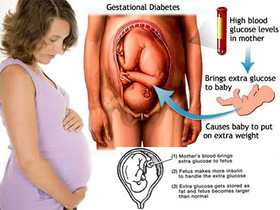 Diabetes that appears for the first time in pregnancy is called gestational diabetes, and affects 5 to 20% of pregnant women. High blood sugar – also known as hyperglycemia – in pregnancy is associated with adverse outcomes for both mother and child, including higher rates of pre-eclampsia, caesarian section, babies born large for their gestational age and shoulder dystocia, and hypoglycemia in newborns. We also know that treatment of gestational diabetes decreases the risk of these complications. Gestational diabetes is caused by an imbalance between the capacity of the pancreas to secrete insulin and the sensitivity of different tissues such as fat, liver and muscles to insulin. During pregnancy, these tissues become less sensitive to insulin because of hormonal changes that occur.
We can refine our definition of gestational diabetes by whether the imbalance is caused more by inadequate insulin secretion or low insulin sensitivity. In a large prospective cohort of about 800 pregnant women called Gen3G, we found that about half of the women with gestational diabetes had predominantly an insulin sensitivity defect, meaning that while their pancreas may make enough insulin, their tissues fail to respond to it. About 30% have mainly an insulin secretion defect, meaning that their pancreas makes too little insulin for the demands that pregnancy hormones induce on the body. Less than 20% have a mix of both defects. We showed that women with gestational diabetes due to an insulin sensitivity defect are the ones at higher risk of complications at delivery, with a higher rate of newborns classified as large-for-gestational age and that experience hypoglycemia soon after birth. These women are also more likely to need a caesarian section to deliver the baby. Pregnant women with gestational diabetes due to low insulin sensitivity had a higher BMI prior to pregnancy, but the risk of higher complications remained significant even after accounting for mother’s weight status. These higher rates of complications in pregnant women with gestational diabetes due to low insulin sensitivity were observed despite all women with gestational diabetes receiving similar clinical care and tight control of maternal glucose. This suggests factors other than maternal hyperglycemia might contribute to the rate of complications, such as inflammatory cytokines, adipokines, or some lipid fractions that increase with lower insulin sensitivity. Future studies will need to identify factors that might be contributing to these complications, and to assess whether we can target or treat these metabolic anomalies in addition to controlling maternal glucose.
0 Comments
Your comment will be posted after it is approved.
Leave a Reply. |
©2017 WeighingInBlog. All rights reserved. 401 Park Drive, Boston, MA




 RSS Feed
RSS Feed

